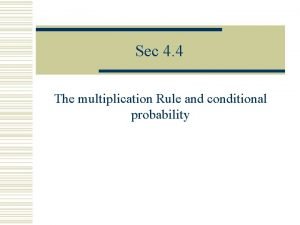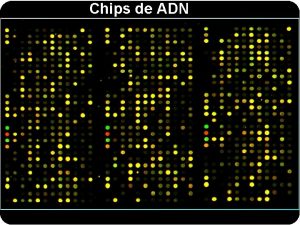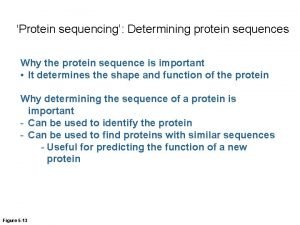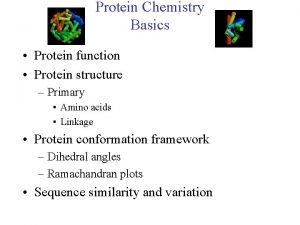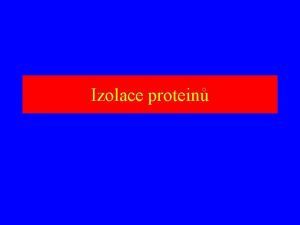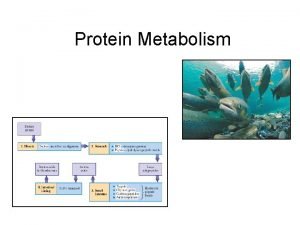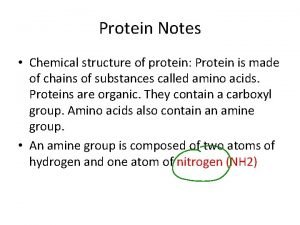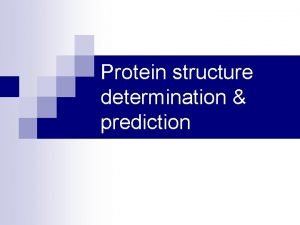V Protein Chips 1 What is Protein Chips




















- Slides: 20

V. Protein Chips 1. What is Protein Chips 2. How to Make Protein Chips 3. MS-Based Protein Chip: SELDI

A protein microarray (or protein chip) is a highthroughput method used to determine the interactions, amounts and activities of proteins on a large scale. Large numbers of different molecules of protein have be arrayed on a support surface and then analyzed by a labeled probe or sample in parallel.

Motivation for Development of Protein Chips Protein chips were developed due to the limitations of using DNA chips for determining gene expression levels in proteomics. The quantity of m. RNA in the cell often doesn’t reflect the expression levels of the proteins they correspond to. Additionally post-translational modifications, which are often critical for determining protein function, are not visible on DNA microarrays.




Protein Attachment n n Diffusion n Protein suspended in random orientation, but presumably active Adsorption/Absorption n Some proteins inactive Covalent attachment n Some proteins inactive Affinity n Orientation of protein precisely controlled Diffusion Adsorption/ Absorption Covalent Affinity Benfey & Protopapas, 2005

Protein Interactions n n Different capture molecules must be used to study different interactions Examples n Antibodies (or antigens) for detection n Proteins for protein-protein interaction n Enzyme-substrate for biochemical function Antigen– antibody Protein– protein Aptamers Enzyme– substrate Receptor– ligand Benfey & Protopapas, 2005

Protein Array VS DNA Microarray Target: Binding: Stability: Surface: Printing: Amplification: Proteins (Big, 3 D) 3 D affinity Low Glass Arrayer Cloning DNA (Small, 2 D) 2 D seq High Glass Arrayer PCR

Expression Array § Probes (antibody) on surface recognize target proteins. § Identification of expressed proteins from samples. § Typical quantification method for large # of expressed proteins.

Interaction Array § Probes (proteins, peptides, lipids) on surface interact with target proteins. § Identification of protein interactions. § High throughput discovery of interactions.

Functional Array § Probes (proteins) on surface react with target molecules. § Reaction products are detected. § Main goal of proteomics.

Technical Challenges in Protein Chips 1. Poor control of immobilized protein activity. 2. Low yield immobilization. 3. High non-specific adsorption. 4. Fast denaturation of Protein. 5. Limited number of labels – low mutiplexing

SELDI MS-based Protein. Chip § Utilizes Surface Enhanced Laser Desorption/Ionization Mass Spectrometry (1993) § MALDI MS combined with chromatography (Bioaffinity): surface-MALDI

Protein Analysis by SELDI-MS 1) Apply sample (serum, tissue extract, etc. ) to Protein. Chip® array. 1 2) Wash sample with increasing stringency to remove non-specific proteins. 3) Energy absorbing molecules are added to retained proteins. Following laser desorption and ionization of proteins, Time-of Flight (TOF) mass spectrometry accurately determines their masses 2 3 Source: http: //dir. niehs. nih. gov/proteomics/emerg 3. htm

“SELDIProtein. Chip Array Technology: Protein-Based Predictive Medicine and Drug Discovery Applications” Ciphergen Biosystems, Inc, 237 -241, Vol 4, J. Biomed. & Biotechnol. , 2003

“SELDIProtein. Chip Array Technology: Protein-Based Predictive Medicine and Drug Discovery Applications” Ciphergen Biosystems, Inc, 237 -241, Vol 4, J. Biomed. & Biotechnol. , 2003 SELDIProtein. Chip Array Technology 1. Protein. Chip Array, Protein. Chip Reader, asso. software 2. Surface: hydrophobic, hydrophilic, ion exchange, metal-immobilized, etc… 3. Probes (baits): antibodies, receptors, oligonucleotides 4. Samples: cell lysates, tissue extracts, biological fluids

“SELDIProtein. Chip Array Technology: Protein-Based Predictive Medicine and Drug Discovery Applications” Ciphergen Biosystems, Inc, 237 -241, Vol 4, J. Biomed. & Biotechnol. , 2003 Application 1: Identification of HIV Replication Inhibitor 1. CAF (CD 8+ antiviral factor) though to be related to AIDS development 2. Determined the identity of CAF with SELDI techniques : alpha-defensin -1, -2 and -3 3. Demonstrated de novo discovery of biomarker and multimarker patterns, identification of drug candidates and determination of protein functions

“SELDIProtein. Chip Array Technology: Protein-Based Predictive Medicine and Drug Discovery Applications” Ciphergen Biosystems, Inc, 237 -241, Vol 4, J. Biomed. & Biotechnol. , 2003 Application 2: Multimarker Clinical Assays for Cancer 1. Early detection of cancer – critical in effective cancer treatment 2. Cancer biomarker – massive protein expression profiling 3. High throughput assay for multimarker provided by SELDI array and multivariate software algorithms produced high sensitivity and specificity.

“SELDIProtein. Chip Array Technology: Protein-Based Predictive Medicine and Drug Discovery Applications” Ciphergen Biosystems, Inc, 237 -241, Vol 4, J. Biomed. & Biotechnol. , 2003 Application 3: Biomarker and Drug Discovery Applications in Neurological Disorders 1. SELDIProtein. Chip for Alzheimer’s Disease 2. Wide rage of samples Small sample amount 3. SELDI using antibody protein array : Ab against Nterminal sequence of target peptides (beta-amyloid) 4. Discovered candidate biomarkers, related inhibitors, & their functions and peptide expression levels
 A box contains black chips and white chips
A box contains black chips and white chips A box contains black chips and white chips
A box contains black chips and white chips Carrier vs channel proteins
Carrier vs channel proteins Protein-protein docking
Protein-protein docking Mnemonic
Mnemonic Potato chips introduction
Potato chips introduction A bag contains 26 letters and 10 numerals
A bag contains 26 letters and 10 numerals Casey fagan
Casey fagan Red white and blue tortilla chips
Red white and blue tortilla chips Bart dyer
Bart dyer I'd rather take baths with a man-eating shark
I'd rather take baths with a man-eating shark I'd rather take baths with a man-eating shark
I'd rather take baths with a man-eating shark Technologies for network based system in cloud computing
Technologies for network based system in cloud computing Calculate intake and output
Calculate intake and output I'm staying at ___ hotel on ____ hudson river *
I'm staying at ___ hotel on ____ hudson river * Pizza and chips song
Pizza and chips song Woher kommt fish and chips
Woher kommt fish and chips Every cook praises his own broth
Every cook praises his own broth Chiptest
Chiptest Advantage and disadvantage of lays chips
Advantage and disadvantage of lays chips Ali chips
Ali chips

